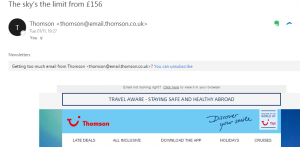The sky’s the limit from £156 – but did Thomson’s email tempt me?
Following a trip to The Maldives (Yes, The Maldives!), Thomson are keen for me to re-book. In this blog I am going to analyse an email from Thomson. The email is not spam, I ‘opted in’ to receive Thomson emails when first booking for the automated ‘booking confirmation’ but also giving permission regarding future deals.
The email is two pages long and therefore of average promotional length consisting of a short catalog structure. The remainder of the page is made up of T&C’s and links to additional info. Executing tactics such as length, size and layout play a decisive role in attracting the recipient (Rossiter, 1981).
The frequency of emails increased when returning from my holiday, with the hope I may be tempted to re-book during a period of ‘post holiday blues’, appealing to the emotional side of consumer interaction. I currently receive an email every four days; I find this excessive given the novelty of booking a holiday. I received the email in question at 7:27pm on Tuesday 1st November. ‘Targeted timing’ does not appear to be in use given a majority of commercial emails are usually received during the working day according to Chadwick and Doherty (2012). ‘Seasonal timing’ may be in use given the email was sent shortly after the daylight saving clock change and at a time when Christmas becomes a conversation point; a period in which many ‘Brits’ now prefer to spend abroad.
The email subject line “The Sky’s the limit from £156” is not descriptive or specific but did draw my attention due to the cheap price. I felt the subject line could have linked more effectively to the email headline of “Our top spots for stargazing”.
Illustrations in the form of high definition images are used to present destinations and engaged me immediately. A large impactful image is used as the header with the headline overlaid to indicate the category of destinations. Animation and interactive features are not used within the email. Features could have been used to enhance the focus on stars/stargazing but may have reduced the professional outlook. As expected, the brand logo is displayed in the top left hand corner.
The message content is minimal with short destination titles and the main ‘call to action’ being for readers to ‘find out more’ about a destination of choice with a click through leading to a booking page. 10 hyperlinks are used in total, consisting of links to the Thomson website and additional information with the option to ‘unsubscribe’. The email flows well with the Thomson navigation bar at the top creating consistency and images encouraging readers to scroll further. One of the major flaws in the flow is the “Travel aware, staying safe and healthy abroad” link which is situated at the very top of the email, breaking up the flow between the subject and headline. The email uses space effectively when advertising destinations but is less aesthetically pleasing at the bottom of the page with numerous links, opening times, T&C’s, addresses and more clustered together.
The landing page itself is consistent with the email. When clicking through readers are taken directly to the website in correspondence with the destination. The page presents readers with a short destination intro, additional links and then the option to easily select dates, airports, hotels and more.
The purpose of the email was to offer value to customers at all stages of the conversation lifecycle. My email was not personalized despite the fact I am a Thomson’s customer. I needed this email to be tailored based on my personal preferences. I have not expressed any interest in stargazing or winter breaks and therefore, on this occasion, Thomson’s did not gain my repeat business. Despite this, the effective soft tone of the email as described by Mohammedi et al. (2013) using words such as “find out more” rather than “click here to buy” meant I did not feel pressured into a hard sale and was happy to skim read and view images.
Thompson will need to use personalisation to ensure direct relationship maintenance with me, Krishnamurthy, S. (2001). In order for Thomson to reach the advocacy stage of the Chaffey (2012) RACE model, I expect the company to incentivise any potential re-booking.
For more information on travel email marketing, follow the link – http://www.pure360.com/travel-email-marketing/



References:
Chaffey, D. (2012) E-Business & E-Commerce Management, Pearson
Ellis-Chadwick, F & Doherty, N.F. (2012). Web advertising: The role of e-mail marketing. Journal of Business Research. 65 (1), p843-848.
Krishnamurthy, S. (2001), “A Comprehensive Analysis of Permission Marketing”, Journal of Computer Mediated Communication, v.6, n.2.
Mohammadi, M., Malekian, K., Nosrati, M., & Karimi, R. (2013). Email Marketing as a Popular Type of Small Business Advertisement: A Short Review. Australian Journal of Basic and Applied Sciences, 7(4), 786-790.
Rossiter, J. R. (1981) “Predicting Starch Scores” Journal of Advertising Research 21(5) pp 63- 68.